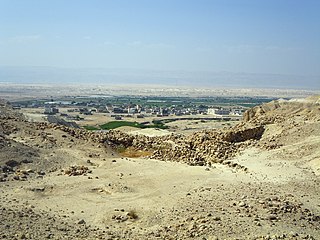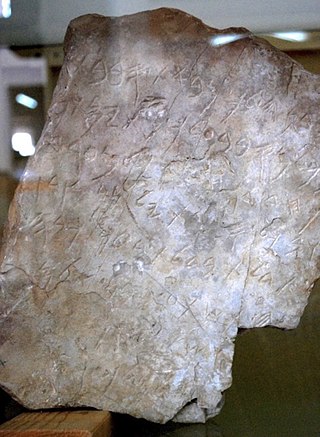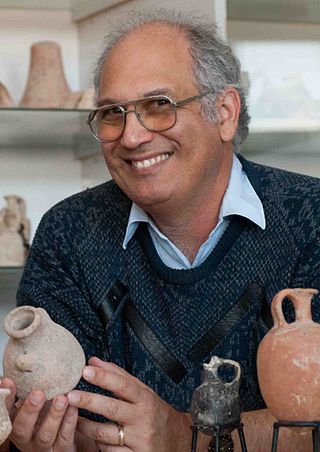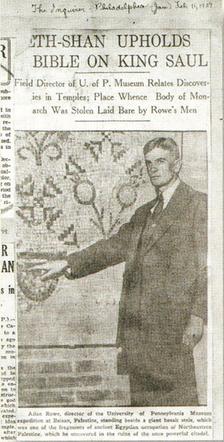
William Foxwell Albright was an American archaeologist, biblical scholar, philologist, and expert on ceramics. He is considered "one of the twentieth century's most influential American biblical scholars", having became known to the public in 1948 for his role in the authentication of the Dead Sea Scrolls. His scholarly reputation arose as a leading theorist and practitioner of biblical archaeology.

The Kura–Araxes culture was a civilization that existed from about 4000 BC until about 2000 BC, which has traditionally been regarded as the date of its end; in some locations it may have disappeared as early as 2600 or 2700 BC. The earliest evidence for this culture is found on the Ararat plain; it spread north in the Caucasus by 3000 BC.
Bimal Krishna Matilal was an eminent British-Indian philosopher whose writings presented the Indian philosophical tradition as a comprehensive system of logic incorporating most issues addressed by themes in Western philosophy. From 1977 to 1991, he was the Spalding Professor of Eastern Religion and Ethics at the University of Oxford.

The Gezer calendar is a small limestone tablet with an early Canaanite inscription discovered in 1908 by Irish archaeologist R. A. Stewart Macalister in the ancient city of Gezer, 20 miles west of Jerusalem. It is commonly dated to the 10th century BCE, although the excavation was unstratified and its identification during the excavations was not in a "secure archaeological context", presenting uncertainty around the dating.

Bab edh-Dhra is the site of an Early Bronze Age city located near the Dead Sea, on the south bank of Wadi Kerak with dates in the EB IB, EB II, EB III and EB IVA. Bab edh-Dhra was discovered in 1924 on an expedition led by William F. Albright.

Martin Litchfield West, was a British philologist and classical scholar. In recognition of his contribution to scholarship, he was awarded the Order of Merit in 2014.
Al-Mina is the modern name given by Leonard Woolley to an ancient trading post on the Mediterranean coast of northern Syria, in the estuary of the Orontes River, near Samandağ, in Hatay Province of Turkey.

Samaria was a city in the historical region of Samaria that served as the capital of the northern Kingdom of Israel during the 9th and 8th centuries BCE. Towards the end of the 8th century BCE, possibly in 722 BCE, Samaria was captured by the Neo-Assyrian Empire and became an administrative center under Assyrian, Babylonian, and Persian rule. During the early Roman period, the city was expanded and fortified by Herod the Great, who renamed it "Sebastia" in honor of emperor Augustus.
Michael Patrick O'Connor was an American scholar of the Ancient Near East and a poet. With the field of ANE studies he was a linguist of Semitic languages, with a focus on biblical Hebrew and biblical poetry.

The Amman Citadel Inscription is the oldest known inscription in the so-called Ammonite language. It was discovered in 1961 in the Amman Citadel, and first published in full in 1968 by Siegfried Horn. At the time of its discovery it was the third longest Semitic stone inscription ever found in the Southern Levant, after the Mesha Stele and the Siloam inscription. The inscription is known as KAI 307. As of 1969, the inscription was on display at the Jordan Archaeological Museum.
Stephanie Mary Dalley FSA is a British Assyriologist and scholar of the Ancient Near East. She has retired as a teaching Fellow from the Oriental Institute, Oxford. She is known for her publications of cuneiform texts and her investigation into the Hanging Gardens of Babylon, and her proposal that it was situated in Nineveh, and constructed during Sennacherib's rule.

Steven A Rosen is the Canada Chair in Near Eastern Archaeology in the Archaeological Division of the Department of Bible, Archaeology and Ancient Near East at Ben-Gurion University of the Negev. He serves as the Vice President for External Affairs. His research has focused on two general areas, the continued use of chipped stone tools in the periods during which metals were already exploited, and the archaeology of mobile pastoralists, using the Negev as an in-depth case study.

Alan Jenvey Rowe was a British archaeologist most famous for his studies on ancient Egypt. Rowe was an Egyptologist and lecturer in Near Eastern Archaeology in Manchester University.

Tell el-Hammam is an archaeological site in Jordan, in the eastern part of the lower Jordan Valley close to the mouth of the Jordan River. The site has substantial remains from the Chalcolithic, Early, Intermediate and Middle Bronze Age, and from Iron Age II. There are different attempts at identifying the site with a biblical city.
The Book of Joshua lists almost 400 ancient Levantine city names which refer to over 300 distinct locations in Israel, the West Bank, Jordan, Lebanon and Syria. Each of those cities, with minor exceptions is placed in one of the 12 regions, according to the tribes of Israel and in most cases additional details like neighbouring towns or geographical landmarks are provided. It has been serving as one of the primary sources for identifying and locating a number of Middle Bronze to Iron Age Levantine cities mentioned in ancient Egyptian and Canaanite documents, most notably in the Amarna correspondence.

Khirbet Shema is an archaeological site located in Israel at the foot of Mount Meron. It features the ruins of a large Jewish village of the Roman and Byzantine periods, including the remains of an ancient synagogue and a mausoleum. It may be identified with the ancient Teqoa of Galilee.

Umm Al Amad, or Umm el 'Amed or al Auamid or el-Awamid, is an Hellenistic period archaeological site near the town of Naqoura in Lebanon. It was discovered by Europeans in the 1770s, and was excavated in 1861. It is one of the most excavated archaeological sites in the Phoenician heartland.
This is a select bibliography of post World War II English language books and journal articles about the Russia during the First World War, the period leading up to the war, and the immediate aftermath. For works on the Russian Revolution, please see Bibliography of the Russian Revolution and Civil War. Book entries may have references to reviews published in English language academic journals or major newspapers when these could be considered helpful.













